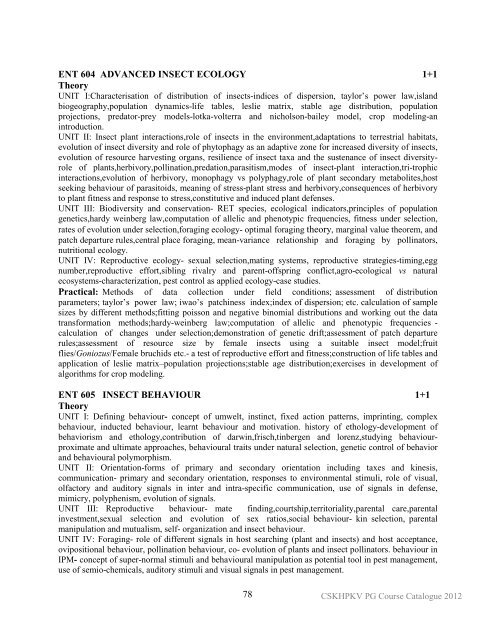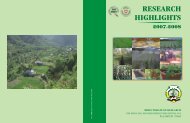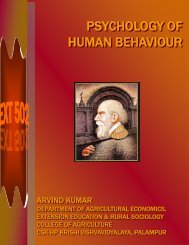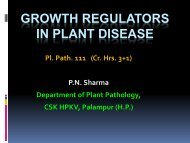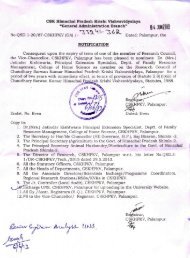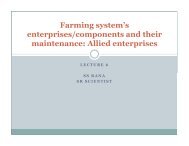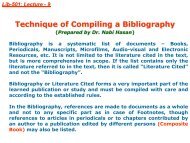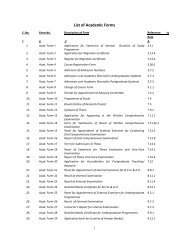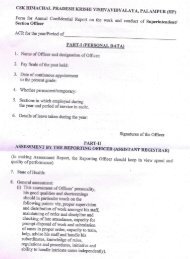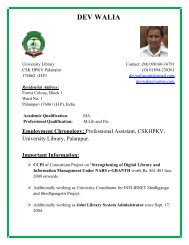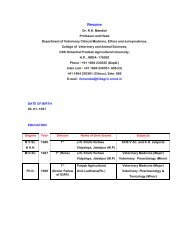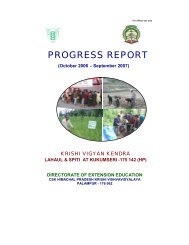course catalogue - CSK Himachal Pradesh Agricultural University
course catalogue - CSK Himachal Pradesh Agricultural University
course catalogue - CSK Himachal Pradesh Agricultural University
You also want an ePaper? Increase the reach of your titles
YUMPU automatically turns print PDFs into web optimized ePapers that Google loves.
ENT 604 ADVANCED INSECT ECOLOGY 1+1<br />
Theory<br />
UNIT I:Characterisation of distribution of insects-indices of dispersion, taylor’s power law,island<br />
biogeography,population dynamics-life tables, leslie matrix, stable age distribution, population<br />
projections, predator-prey models-lotka-volterra and nicholson-bailey model, crop modeling-an<br />
introduction.<br />
UNIT II: Insect plant interactions,role of insects in the environment,adaptations to terrestrial habitats,<br />
evolution of insect diversity and role of phytophagy as an adaptive zone for increased diversity of insects,<br />
evolution of resource harvesting organs, resilience of insect taxa and the sustenance of insect diversityrole<br />
of plants,herbivory,pollination,predation,parasitism,modes of insect-plant interaction,tri-trophic<br />
interactions,evolution of herbivory, monophagy vs polyphagy,role of plant secondary metabolites,host<br />
seeking behaviour of parasitoids, meaning of stress-plant stress and herbivory,consequences of herbivory<br />
to plant fitness and response to stress,constitutive and induced plant defenses.<br />
UNIT III: Biodiversity and conservation- RET species, ecological indicators,principles of population<br />
genetics,hardy weinberg law,computation of allelic and phenotypic frequencies, fitness under selection,<br />
rates of evolution under selection,foraging ecology- optimal foraging theory, marginal value theorem, and<br />
patch departure rules,central place foraging, mean-variance relationship and foraging by pollinators,<br />
nutritional ecology.<br />
UNIT IV: Reproductive ecology- sexual selection,mating systems, reproductive strategies-timing,egg<br />
number,reproductive effort,sibling rivalry and parent-offspring conflict,agro-ecological vs natural<br />
ecosystems-characterization, pest control as applied ecology-case studies.<br />
Practical: Methods of data collection under field conditions; assessment of distribution<br />
parameters; taylor’s power law; iwao’s patchiness index;index of dispersion; etc. calculation of sample<br />
sizes by different methods;fitting poisson and negative binomial distributions and working out the data<br />
transformation methods;hardy-weinberg law;computation of allelic and phenotypic frequencies -<br />
calculation of changes under selection;demonstration of genetic drift;assessment of patch departure<br />
rules;assessment of resource size by female insects using a suitable insect model;fruit<br />
flies/Goniozus/Female bruchids etc.- a test of reproductive effort and fitness;construction of life tables and<br />
application of leslie matrix–population projections;stable age distribution;exercises in development of<br />
algorithms for crop modeling.<br />
ENT 605 INSECT BEHAVIOUR 1+1<br />
Theory<br />
UNIT I: Defining behaviour- concept of umwelt, instinct, fixed action patterns, imprinting, complex<br />
behaviour, inducted behaviour, learnt behaviour and motivation. history of ethology-development of<br />
behaviorism and ethology,contribution of darwin,frisch,tinbergen and lorenz,studying behaviourproximate<br />
and ultimate approaches, behavioural traits under natural selection, genetic control of behavior<br />
and behavioural polymorphism.<br />
UNIT II: Orientation-forms of primary and secondary orientation including taxes and kinesis,<br />
communication- primary and secondary orientation, responses to environmental stimuli, role of visual,<br />
olfactory and auditory signals in inter and intra-specific communication, use of signals in defense,<br />
mimicry, polyphenism, evolution of signals.<br />
UNIT III: Reproductive behaviour- mate finding,courtship,territoriality,parental care,parental<br />
investment,sexual selection and evolution of sex ratios,social behaviour- kin selection, parental<br />
manipulation and mutualism, self- organization and insect behaviour.<br />
UNIT IV: Foraging- role of different signals in host searching (plant and insects) and host acceptance,<br />
ovipositional behaviour, pollination behaviour, co- evolution of plants and insect pollinators. behaviour in<br />
IPM- concept of super-normal stimuli and behavioural manipulation as potential tool in pest management,<br />
use of semio-chemicals, auditory stimuli and visual signals in pest management.<br />
78 <strong>CSK</strong>HPKV PG Course Catalogue 2012


